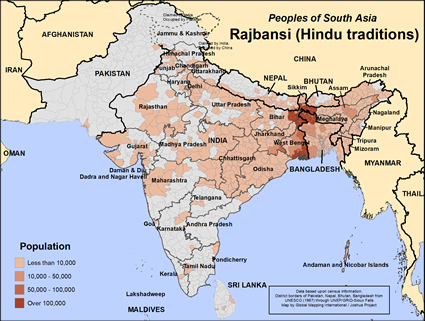Rajbansi (Hindu traditions) in Nepal

Photo Source:
Copyrighted © 2026
International Mission Board-SBC All rights reserved. Used with permission |

Map Source:
People Group Location: Omid. Other geography / data: GMI. Map Design: Joshua Project
|
| People Name: | Rajbansi (Hindu traditions) |
| Country: | Nepal |
| 10/40 Window: | Yes |
| Population: | 120,000 |
| World Population: | 8,768,000 |
| Primary Language: | Rajbanshi |
| Primary Religion: | Hinduism |
| Christian Adherents: | 5.38 % |
| Evangelicals: | 2.69 % |
| Scripture: | New Testament |
| Ministry Resources: | Yes |
| Jesus Film: | Yes |
| Audio Recordings: | Yes |
| People Cluster: | South Asia Dalit - Rajbansi |
| Affinity Bloc: | South Asian Peoples |
| Progress Level: |
|
Introduction / History
The Rajbansi are one of many different ethnic groups who live in the small, mountainous country of Nepal. Their almost forgotten, rugged land lies sheltered at the foot of the Himalayan Mountains, sandwiched between India to the south and Tibet to the north. Most live in India and the eastern section of the Jhapa District and in the adjoining Koshi District of Nepal. A small number are in Bhutan.
The Rajbansi are a dark-skinned people of medium height who have been described as tough. Their language is called Rajbanshi and is similar to that of the Bengali of West Bengal. Many of the younger generation are bilingual in Nepali, Nepal's official language, but older Rajbansi only speak their native language.
The Rajbansi migrated to Nepal approximately 300 years ago, and although their origins are unclear, they are probably related to the larger Koch peoples of India. One legend says they are the descendants of the children of a Bengali man and an Arakan woman. Other legends declare them to be an ancient people descended from the Dravidian race who lived in southern India.
What Are Their Lives Like?
Most Rajbansi are subsistence farmers. They survive on the produce of their labor. The main foods of the Rajbansi are barley, potatoes, wheat, vegetables and dairy products. Although they raise livestock, they do not seem to consider the animals as a primary source of income. Instead, animal products are used as items to sell to purchase necessities that they can't make or grow themselves. A shortage of suitable arable land and poor farming methods all contribute to a low level of food production. They are excellent weavers, and some have begun to earn money by their weaving. Others work for the government or find employment in the private sector. As a whole, they live impoverished lives. The Rajbansi are hesitant to change their lifestyle, and they struggle to learn new types of work.
Rajbansi houses are made of wood, bamboo, thatch and mud are clustered in villages ranging from ten to one hundred buildings. As in all patriarchal societies, the father is the undisputed head of the household. Most homes are composed of a basic family unit (parents and their children) until the oldest son marries. He and his wife then live with his parents until the second son marries. When the family head dies, all authority and responsibilities are transferred to the eldest son. Most marriages are arranged, and weddings are conducted according to traditional Hindu rites and rituals.
What Are Their Beliefs?
The Rajbansi are Hindus who mix their Hinduism with folk religion. Every Rajbansi village has a separate hut dedicated to the worship of the Hindu goddess of death and sex, Kali. Though the Rajbansi celebrate the Hindu festivals of Dasai and Tihar, the Rajbansi do not observe them the same way Hindus do in India. Like many tribal peoples, the Rajbansi do not use Brahmins but have their own priests, monks and shamans. Their religion consists of paying proper respect to their ancestors and appeasing evil spirits by performing various rituals.
There is a tiny group of believers among the Rajbansi in Nepal that doesn't exist in other countries of South Asia.
What Are Their Needs?
The JESUS Film is available, and Christian audio recordings are useful evangelistic tools.
The Rajbansi have had limited chances of hearing the Gospel of Jesus Christ. However, there are some Christ-followers among them who can take the life-saving gospel to their neighbors. Their isolation also makes it difficult for outsiders to reach them. In addition, people like the Rajbansi who practice pantheism (the worship of many gods) find it very difficult to lay aside such beliefs and put all of their faith in one God.
Prayer Points
Pray that God will strengthen and protect the small number of believers among the Rajbansi in Nepal and use them to disciple others.
Pray for the Rajbansi people, in both India and Nepal, to have the spiritual hunger it takes to embrace Christ no matter what the cost.
Pray that God would bring about church planting efforts among the Rajbansi.